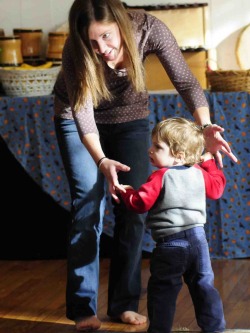Our Program
At Music for Children, we believe that music should be experienced in a way that engages the body, mind and imagination. Our developmentally-appropriate curriculum is unique in that it grows with your child from the toddler years through to age seven. Our program focuses on the whole child—fostering not only musicality and coordination, but self-confidence, social-emotional connections, and creativity.
Each class, at every level, is designed as an artful whole, meaning there is an arc to the lesson. The experiences flow from the very beginning movements of the class to the grande finale, by way of our Once Upon A Song Stories™ approach. This style of thematic learning allows children to make real world connections to the music while internalizing the concepts through creative drama, dance, and imaginary play. For example, one of our lessons in the Threes program is entitled, “Going Fishing”:
Each class, at every level, is designed as an artful whole, meaning there is an arc to the lesson. The experiences flow from the very beginning movements of the class to the grande finale, by way of our Once Upon A Song Stories™ approach. This style of thematic learning allows children to make real world connections to the music while internalizing the concepts through creative drama, dance, and imaginary play. For example, one of our lessons in the Threes program is entitled, “Going Fishing”:
- When we swim, splash and dive with the fish puppets in Schubert’s Die Forelle, we are experiencing musical form, mood, and dynamics through a teacher-guided dance.
- When we "build a wall" around Bonavist Harbor, we are learning about phrasing, cultural traditions, and community with a circle dance.
- When we read a simple rhythm (on a fish!) and apply the corresponding physical movement within the imaginary play, we give value to the music and make the lesson a lasting memory.(*see below)
- When we travel to the Crawdad Hole, we match pitch through echoes; we strengthen the mind-body connection by singing while galloping/walking/running; and we use our imaginations to set the scene.
- When the piano "puts us to sleep and wakes us up" at the Bottom of the Sea, we are responding to musical clues, including dynamics, register, modality, tempo, and rhythm.
- When we play a rich collection of ocean-sounding instruments, we are improvising, sharing, and building a sense of confidence.
*Our program draws from modern day research and celebrated schools of musical thought, including the Dalcroze Eurhythmics approach to music learning:
“The body is trained to be the instrument, not only of the performance of eurhythmics, but of the perception of music. The body is understood as the original musical instrument, the one through which everyone first realizes music in both its senses: apprehending and creating, and the primary, personal, trainable utensil for musical understanding and production. The movements a student makes in a eurhythmics class do not have the essential purpose of training the body to convey a choreographic picture to an audience. Rather, their essential purpose is to convey information back to the mover himself. The movements set up a circuit of information and response moving continuously between brain and body, which, with training and experience, rise to ever higher levels of precision, coordination, and expressive power.”
- http://www.dalcrozeusa.org/history.html
- http://www.dalcrozeusa.org/history.html
